Laskarina Bouboulina, Greek Rebel Admiral
Laskarina Bouboulina was born in chains, both figuratively and (in a way) literally. She was conceived during one of her mother’s conjugal visits to her father in a prison in Istanbul and was born nine months later in May of 1771. Her father Stavrianos Pinotsis was Greek, and at the time Greece was under the control of the Ottoman Empire. He had taken part in the “Orlov Rebellion”, so called because it had been started by the arrival of a Russian admiral named Alexey Orlov. He had been sent by Catherine the Great as part of her plan to weaken the Ottomans and divide their forces by stirring up rebellion. Initially the rebellion had some great successes, but the Russians never delivered the land troops they’d promised to support the rebels and eventually they weren’t able to hold out against the military might of the Ottomans. The revolt was crushed, the Greek civilians paid a heavy price as Turkish mercenaries carried out retaliatory massacres, and the Russians considered the whole thing a great success as it had drawn the Ottoman forces away from the front of their war with Russia. This allowed Russia to force the Ottomans into a treaty that gave them a border much further south than it had been, which was what they had been after all along. (In fact, it was this treaty that led to the circumstances that allowed them to annex the Crimea in 1783.)
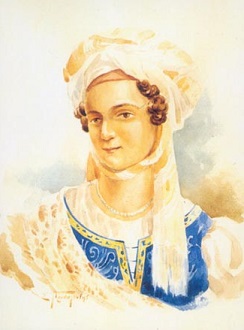
That treaty included no provisions for the Greeks who had risen on the promise of Russian aid that never came, and this taught the survivors of the failed rebellion a harsh lesson in who they could trust. Stavrianos Pinotsis was not one of those survivors, though. By that time he had died in that Turkish prison, and his widow Skevo had taken their daughter back to the island of Hydra where the couple had originally lived. In 1775 she remarried, and they moved to the nearby island of Spetses. Laskarina grew up in a large family, with many half-brothers and half-sisters. Despite her status as a step-sibling she still ruled the roost, and commanded her army of siblings as they romped around the island. But she never forgot that her father had been taken away from her by the Turks.
Laskarina grew up in the shadow of the Enlightenment, the philosophical and cultural change that enveloped Europe as the printing press brought knowledge to the masses. When she was 18 years old the French Revolution began, proving to the oppressed peoples of Europe that liberation needn’t just be a dream. The Greek scholar Adamantios Korais lived in Paris during the Revolution; and there he wrote many books that were published in Greece with the help rich members of the merchant class. Korais was a supporter of Greek independence and a critic of the Greek Orthodox Church’s tacit support of the Ottoman rulership. He wrote in support of the Greeks who fought in the French ranks against the Ottomans in Egypt; and thought that a French alliance could help Greece. (Like many Englightenment scholars however he soon soured on “Emperor” Napoleon; and saw him as the same old tyranny of kings reincarnated.) He also created the first dictionary of Modern Greek; a nationalistic unifying force that helped to set the stage for what was to come.
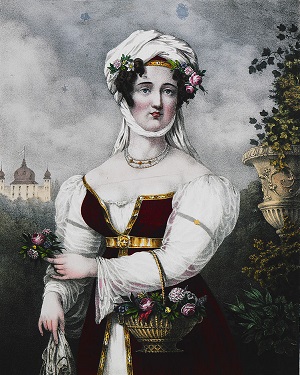
By then the adult Laskarina was a leading member of the merchant classes who consumed and discussed Korais’ work. She had always had a passion for the sea, and both of her husbands were successful merchant captains. She married Dimitrios Yiannouzas when she was seventeen years old; but he fell in a fight with the Algerian pirates who were a constant menace to Mediterranean shipping. The same fate befell her second husband; a merchant named Dimitrios Bouboulis. In 1711 he was captaining a ship that was ambushed by two pirate ships working together and led a defense that successfully defeated both of them. He didn’t live to see the victory though; a bullet caught him in the head and killed him just as the tide turned in the battle. A relative on board the ship took over command, concealing the fact that Dimitrios had died until the battle had been won.
At the age of forty, Laskarina was a widow for the second time. She never remarried, and so kept the surname of Bouboulina for the rest of her life. Her husbands gave her seven children and a fortune that she turned into the foundation of a merchant empire. She was the partner in several trading vessels and soon began having her own built to sail the waters. At the time the Napoleonic wars had caused several trade embargoes to be put in place between the warring nations, and ambitious Greek merchants willing to risk smuggling in defiance of them made huge amounts of money. In fact, the captains became so wealthy that they started burying their gold in order to avoid the risks of appearing to successful. Bouboulina fell afoul of those risks in 1816, when the Ottoman Empire decided to try to take everything that she had away from her.
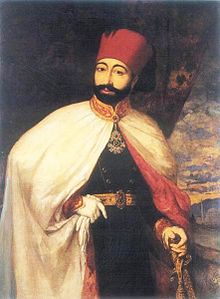
The justification for this confiscation was Dimitrios Bouboulis; or rather the fact that he had fought on board a Russian ship ten years earlier during the last of the many wars between them and the Ottomans. The fact that they had waited until his widow had amassed such a large fortune was purely coincidental, of course. At the time Russia and the Ottomans were at peace, so Bouboulina sailed to Istanbul to meet with the Russian ambassador and seek his help with the situation. Her family might not have had a good track record with Russian aid, but she was influential enough that he saw the merit in helping her. He introduced her to Nakshidil, the mother of the Sultan Mahmud II. Nakshidil had been a concubine, born into freedom and captured as a slave before she was sold to the harem. [1] The two woman became friends of a sort. While she took refuge in the Crimea with the Russians, Nakshhidil convinced her son to have the officials grant Bouboulina an amnesty for her husband’s actions.
It was around this time that Bouboulina probably joined Filiki Eteria, a secret society trying to gain Greek independence. (We can’t be certain because it was, after all, a secret society.) Filiki Eteria (literally “the friendly society”, a good unobtrusive name) was founded in 1814 by three Greek patriots, inspired by other European secret societies. (The most notable of these was the Carbonari, an Italian secret society seeking independence from the Austrians.) It also drew heavily on Freemasonry and used a deliberate theatricality to enhance its reputation. Originally its leadership was “the Invisible Authority”, but eventually its leaders became known as “the Twelve Apostles”. [2] Over the next few years it would grow to have over two thousand members across Greece, becoming the organising force for a new rebellion.
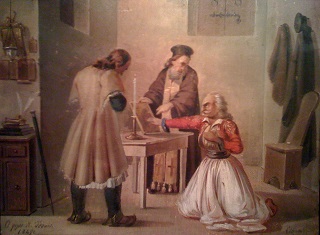
Bouboulina wasn’t just an idle member of the society. Her trading fleet provided the ideal cover for the construction of warships disguised as merchant vessels. The mightiest of these was named Agamemnon, and Bouboulina had to bribe the local officials to get it built. There were normally limits on the size permitted for civilian vessels, but she was able to convince them that she had built it so large in order to get a trading advantage. She was also active in recruiting fighters from Spetses and in smuggling in supplies and weapons for the revolution. This included 18 cannons ready to be fitted on the Agamemnon. By the end of 1820, she had everything in place and was waiting for the war to begin.
1821 was a perfect storm of opportunity for the Greeks. The Ottomans were at war with Persia, drawing their forces to the other side of the Empire. Their Austrian allies were busy dealing with an Italian bid for independence, while France (once again under the control of monarchists) was busy helping the king of Spain maintain his unpopular absolute rule. In February the revolution began in the Balkans, where Alexander Ypsilantis (the leader of Filika Eteria) led his “Sacred Band” of volunteers to try to inspire the locals to rebel alongside him. Though they were largely unsuccessful militarily (and were decisively defeated by June) they did inspire the mainland to follow suit and soon a general rebellion was in full swing.
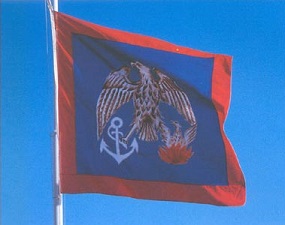
In March of 1821 Laskarina Bouboulina openly joined the rebellion, raising a Greek flag of the Revolution on the mast of the Agamemnon. It was a unique flag of her own design, based on one of the flags of the Byzantine Empire. (At that time, the natives of Greece still referred to themselves as “Romans” in memory of the Eastern Roman Empire they had once ruled.) She became the leader of the first naval force to declare for an independent Greece, a significant achievement for such a maritime nation. She led them to the town of Nafplio, one of the major Ottoman strongholds in Greece, where they blockaded the harbour and began what would be a protracted siege. The town had three forts and was defended by three hundred cannons; the Ottomans considered it impregnable. In the end it held out for a year and a half. Bouboulina personally led several of the attacks during that period, leading her to be described by the historian Anargyros Hatzi-Anargyrou (who also took part in the siege) as “indeed lion-hearted”.
While Bouboulina was tied up besieging Nafplio, the war progressed on other fronts. Despite the fact that the Greek Orthodox Church had constantly opposed the Revolution, the Ottomans publicly executed the Greek Patriarch Gregory V on Easter Sunday in order to send a message to the rebels. This was a major miscalculation; as not only did it drive even more Greeks to take up arms, it also turned the great powers of Europe (who had initially opposed the rebellion on the principle that they opposed all revolutions) against the Ottomans. In general Greeks living in Ottoman territory were subjected to fearsome “reprisals”, and many were killed as a result. As a result of the coverage of these atrocities in the rest of Europe, as well as a general spirit among the upper-classes of sympathy with Greece (fueled by their “classical educations”), led to many volunteers coming to join the revolution. They were few in number but often provided military and medical skills that the Greeks lacked. More significant were the funds raised to support the revolution, especially in America and Russia. This enabled the Greeks to fight on an equal footing with the waning Ottoman Empire.
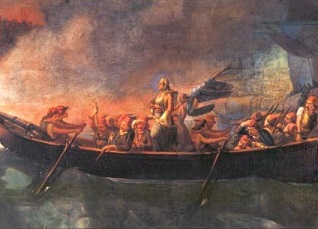
Central Greece rose up in rebellion in the summer of 1821. The Turkish army responded in force, but by the end of the year they had been held off long enough that the rebels were fairly secure in their positions. One casualty of this fighting was Bouboulina’s son Yiannis while fighting in a rearguard defense of the city of Argos. He and his Spetsiot troops were wiped out, but they bought enough time for the civilian population to flee the city. In October of 1821 the city of Tripoli fell to the Greek armies, giving them effective control of the Greek mainland. Bouboulina came to the city on a break from her blockade just in time to witness the walls coming down. This resulted in the Greek troops proved that they were just as capable of committing massacres as the Ottomans given the chance. However in memory of her friendship with Nakshidil; Bouboulina made straight for the harem of the local pasha and was able to protect the women there from the rampaging soldiers. They were among the few survivors. Foreign observers among the army reckoned that around ten thousand Muslim and Jewish inhabitants of the city (including many children and pregnant women) were murdered, accounting for around half of those killed in such massacres in Greece during the year of 1821.
In December of 1821 the Greek National Assembly met for the first time. This put in place a provisional constitution and an executive; marking the beginning of independent Greece. The war was far from over, though. This was brought bloodily home in April of 1822 when the Ottoman fleet landed on the island of Chios. Despite the fact that Chios was one of the few parts of Greece that had not rebelled (due to its proximity to Constantinople and the comfortable wealth of its merchant classes) the soldiers ran riot over the inhabitants. Of the island’s population of 120,000 people only twenty thousand managed to escape. Around half of the remainder were enslaved, the other half were killed outright. (The exact proportions remain a matter of some debate.) Just like that one of the most prosperous of the Greek islands was wiped out, and never recovered.
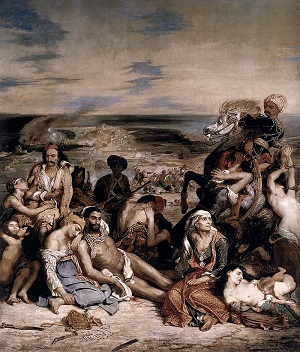
The massacre at Chios further put public opinion in Europe on the side of Greece, and some sabre-rattling from the Russians meant that the Ottomans were forced to keep a large part of their army in reserve on their border. As a result, though the Greeks suffered several defeats throughout 1822 and 1823 they were able to hold the Turkish forces at bay. It was internal conflict that was the real problem. As has been the case many times throughout history, the groups that had come together under the banner of independence turned out to generally share little else in common. Now that they had a country to run, they fell out over the matter of how to run it. Or more specifically, they fell out over the matter of who should run it.
The initial Assembly consisted almost entirely of Peloponnese citizens, natives of the large peninsula that made up the southern half of Greece. Peloponessus had been the first part of the country to revolt and so since it was the first to the table it took all the good seats. As the rebellion expanded the assembly delegates gradually began to reflect the other two main groups of Greeks: Roumeliotes (mainlanders) and Islanders. However the executive branch remained in the hands of the Peloponnesians, and they soon ran into friction with military leaders who did not respect their authority. This led to the outbreak of the first Greek Civil War, which broke out in March of 1824. Bouboulina had a ringside seat to the fighting, as it mostly took place in the city of Nafplion where she was living at the time. Panos Kolokotronis, commander of the city and husband of Bouboulina’s daughter Eleni, was asked to surrender command of the city to the government. His father Theodoros was the vice-president and a member of the Peloponnese clique, and when a Roumeliote president was appointed he refused to serve him. Since Theodoros was the leader of the military forces as well, he thought that trumped civilian authority. [3] It’s worth noting that this means that even though she was an Islander, Bouboulina was allied with the Peloponnesse faction.
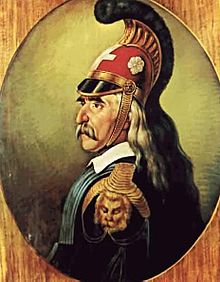
The first Greek Civil War ended in Bouboulina’s allies (and her) being driven from Nafplio. The second, which broke out soon after, resulted in the death of Panos and the imprisonment of Theodoros and his allies. Bouboulina was not one of those allies, but her campaigning for them to be freed resulted in her being arrested twice and eventually confined to the island of Spetses. Theodoros and the othes were imprisoned for several months, and were only released when Egypt decided to take a side in the war. They allied themselves with the Turks (mostly in the hope of carving out part of Greece for themselves). With this threat at the doorstep the fledgling Greek Republic could not afford to have its best generals imprisoned. So Theodoros resumed control of the Greek army, for one more bloody war to save the Republic.
Bouboulina did not manage to take part in that final war, though. She fell before it began, while she was organising a new Spetsiot fleet. Her son Yeorgios eloped with the daughter of a local man named Christodoulos Koutsis. He led a group to Bouboulina’s house to look for the girl, where he was angrily denounced by Bouboulina from a balcony. With tempers flaring, somebody in the Koutsis party fired a shot. It struck Bouboulina in the forehead and she died instantly.
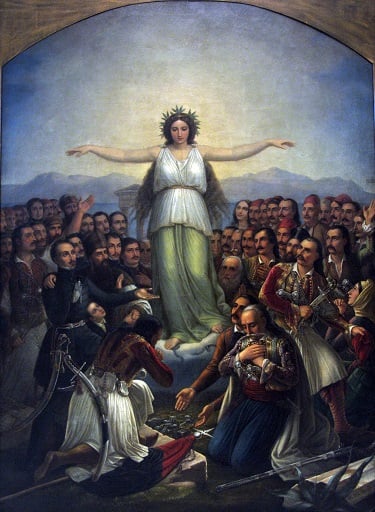
The war raged on, and by 1828 with the support of the European powers Greece had won its independence. It was a lot smaller than Greece is today, as over time more provinces won independence and joined the state. It was also deeply under the control of the European powers; plus ça change. The war marked the turning point in the fortunes of the Ottoman Empire as it began the decline into the position of “sick man of Europe” that it occupied at the beginning of the twentieth century. The war also provided the template for later revolutions in Poland and Hungary as subservient states sought to throw off the chains of empire; though neither of them would succeed until World War I changed the European map completely.
Laskarina Bouboulina became a hero of the new Greek Republic. She was posthumously granted the title of Admiral by the Russian Tsar in recognition of her heroism, making her possibly the first woman in history to bear that title. Her descendants went on to be Greek naval officers, and her home became a shrine to her memory. Perhaps her greatest legacy though was the inspiration she gave to the new country, a symbol of the common people who had risen up to fight for independence. In some ways she was not remarkable, as others did much the same as she did. But it’s the story of the woman born in chains who rose up to break them that has captured people’s imaginations, and continues to do so to this day.
Images via wikimedia and Boubolina Musuem
[1] There was an absurd rumour popular in Europe at the time that Nakshidil was actually a French noblewoman named Aimée du Buc de Rivéry, a cousin of Empress Josephine who had been lost at sea. There is no factual basis for this rumour but it was tacitly encouraged by French diplomats who found that it made it easier to get the French public to accept any agreements they made with the Ottomans if they made them think the Sultan was half-French.
[2] Ironic, since Christianity was for the first two centuries of so of its existence also a secret society based primarily in Greece.
[3] This is all a hugely simplified version of a deeply complex subject, but the same could be said of all history.
